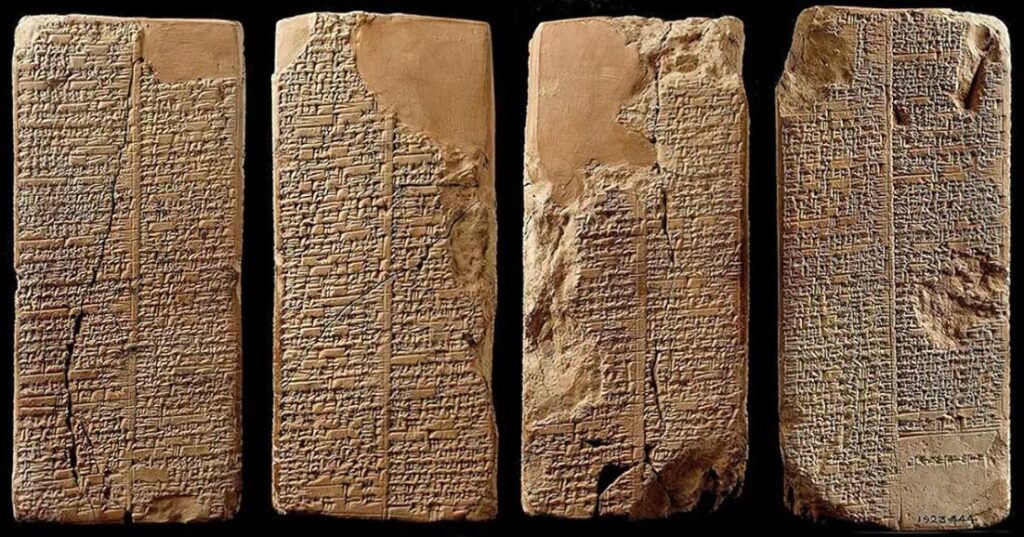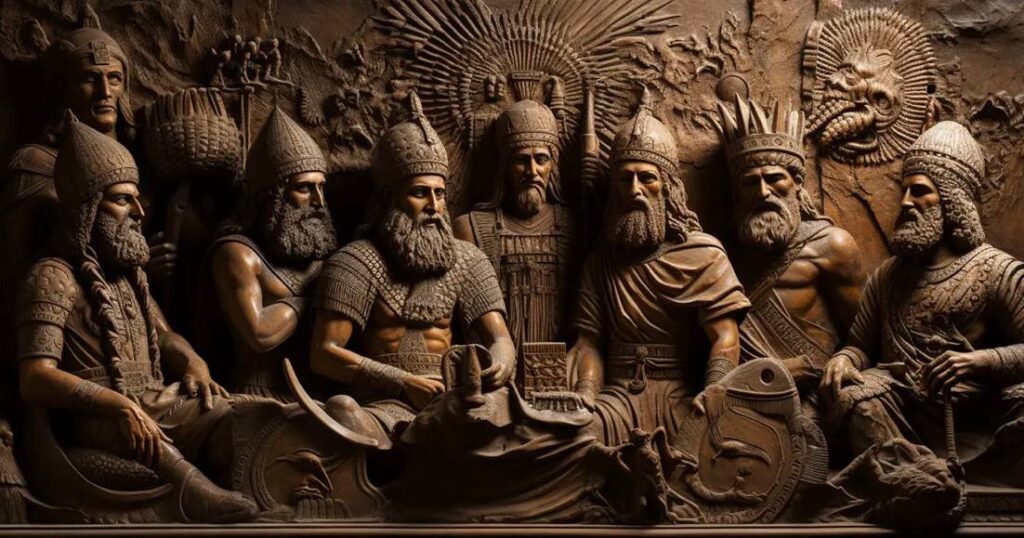Within the historical records of ancient Mesopotamia, the Sumerian King’s List stands out as a puzzling document that has baffled historians for decades. This mysterious ledger allegedly reveals the extraordinary tale of the Earth being ruled by eight enigmatic kings, with their dominion lasting an incredible 241,000 years. The document doesn’t merely list their reigns but also asserts that these sovereigns “descended from heaven.” Exploring the intersection between myth and history, the Sumerian King’s List prompts investigations into the reality of divine entities, particularly the Anunnaki, and their supposed impact on Earth.

The document known as the Sumerian King’s List, carefully copied through generations, documents the governance of eight kings:
1. Alalu: Alalu’s reign in Eridug, the first city to be ruled under the Anunnaki’s domain, set the foundation for what would become a legendary lineage of divine kingship. The challenges and celestial events he faced are thought to have shaped the early development of civilization and the Anunnaki’s interaction with humanity, leaving a lasting imprint on ancient Mesopotamian mythology.
2. Anu: Anu’s accession to the throne marked a significant shift towards stabilizing the realms under his control, with his leadership heralding an era where celestial order was meticulously maintained and divinely influenced events became more pronounced. This epoch under Anu’s rule is often depicted as a golden age of divine governance, where the connection between the gods and the earthly realm was at its zenith, fostering a period of prosperity and spiritual enlightenment among the inhabitants of Earth.
3. Antu: Antu’s long tenure as a ruler is emblematic of her role in maintaining not just the cosmic balance, but also in nurturing the growth and development of the societies under her influence. As Anu’s consort, she is often portrayed as a pivotal figure in the pantheon, whose wisdom and guidance were crucial in upholding the harmony between the celestial and terrestrial domains, ensuring that the cycles of nature and the cosmos remained in perfect alignment.
4. Enki: Enki’s reign is notably marked by significant advancements that propelled early human civilizations into new eras of discovery and innovation. As a deity of wisdom, water, and creation, his contributions extended beyond mere governance, deeply influencing the development of agriculture, writing, and legal systems, which laid the foundational stones for structured societies. His efforts in human creation are particularly celebrated, symbolizing a profound bond between divine beings and humanity, fostering a legacy of knowledge and enlightenment that would echo through the ages.
5. Enlil: Enlil’s governance is often characterized by his vigorous involvement in shaping the destinies of cities and nations, illustrating a profound connection with the Earth and its inhabitants. His stewardship was pivotal in orchestrating the development of agricultural practices and the establishment of societal norms, which played a critical role in the evolution of human civilization. As the lord of the air and the earth, Enlil wielded his powers to foster growth, prosperity, and order, ensuring that humanity thrived under his watchful eye and guidance.
6. Ninmah: Ninmah’s influence extended deeply into the realms of health and fertility, where her nurturing touch was believed to have healed the land and its people, leading to periods of abundance and well-being. Her wisdom and compassion were seen as vital forces in the cultivation of life and the natural world, making her an essential figure in the pantheon for ensuring the prosperity of both the earth and its inhabitants. Through her guidance, ancient societies learned to harmonize with the environment, laying the groundwork for sustainable practices that would benefit future generations.
7. Nannar (Sin): Nannar, also known as Sin, held sway over the night sky, embodying the moon’s cyclical nature and its influence over the Earth’s waters and the fertility of its lands. His reign was characterized by a deepening of humanity’s connection to the rhythms of the cosmos, where lunar cycles became integral to the timing of rituals, agriculture, and social ceremonies. This period saw the emergence of lunar calendars and the development of astronomy, as people sought to understand and predict the celestial patterns that Nannar governed, further intertwining the divine with the everyday lives of ancient civilizations.
8. Ninurta: Ninurta’s reign is remembered for its strategic advancements in warfare techniques and defense mechanisms, which ensured the safety and security of his domain. Simultaneously, he championed agricultural innovation, leading to enhanced crop yields and the stabilization of food supplies. This dual focus not only bolstered the physical well-being of his people but also reinforced the harmony between human societies and the natural world, underlining the interconnectedness of survival, prosperity, and the careful stewardship of the environment.

The compilation ends with the claim that, throughout five cities, eight sovereigns reigned over Earth for an astonishing 241,200 years until a great flood transformed the landscape. This prompts the question: Are these narratives of divine beings descending from the skies and ruling for millennia based on fact, or are they purely mythological? Scholars are divided, analyzing the Sumerian King’s List to discern historical truths within its legendary assertions. The document seems to blend prehistoric and mythical kings with those whose existences are more concretely evidenced. Enmebaragesi of Kish, a monarch dating back to around 2600 BC, emerges as the earliest ruler supported by archaeological findings, confirming his place in history.
Yet, doubts persist, particularly about the extraordinary durations of rule mentioned in the document. While some suggest these figures might serve as metaphors or symbols, there’s also a theory that the Sumerian King’s List is a fusion of historical records and myth, merging truth with legend. The document notably claims that these long-reigning rulers were eventually overthrown by a cataclysmic event – the Great Flood, echoing similar stories from various ancient cultures and hinting at a potentially shared origin for these flood narratives.

Taking the Sumerian King’s List at face value implies a dominion of otherworldly beings, the Anunnaki, over Earth for a vast expanse of time. Are these “descendants from heaven” possibly ancient astronauts, who influenced human progress for more than 241,000 years? On the other hand, some scholars argue that the list might symbolically reflect the ebb and flow of leadership, with sovereignty waxing and waning in a manner akin to celestial patterns.
The endeavor to decipher the Sumerian King’s List involves the difficult task of distinguishing factual history from legendary additions. With Enmebaragesi De Kish standing as the earliest monarch backed by archaeological proof, a semblance of authenticity is provided to the document. Yet, the grand narrative of divine governance invites a wider investigation into how myth and historical fact intertwine.
Ultimately, the Sumerian King’s List is a complex mosaic of authentic historical detail and imaginative myth. Whether it documents the rule of ancient space travelers or symbolizes the cyclicality of governance, the mystery of the text continues to fascinate, drawing seekers of knowledge towards the ancient secrets of Earth’s early days.









